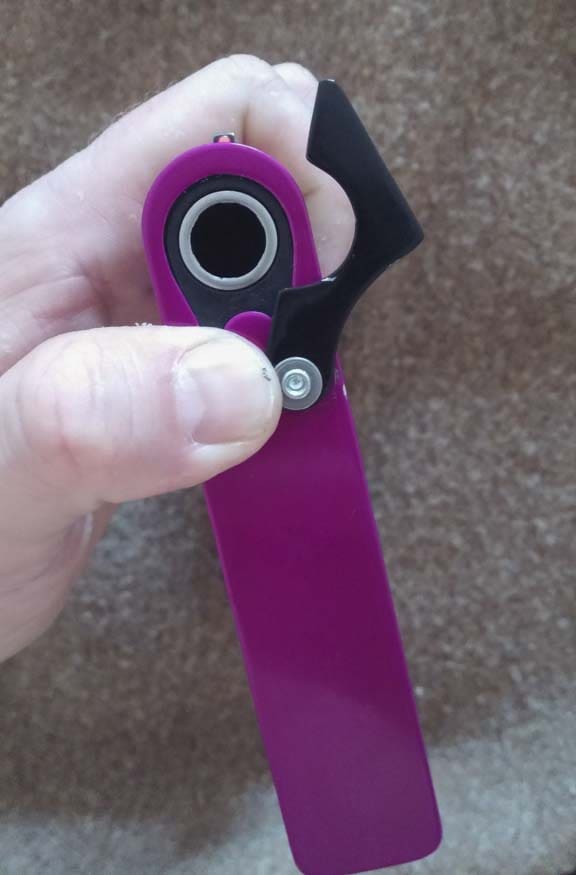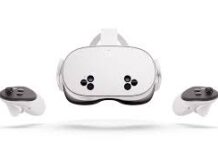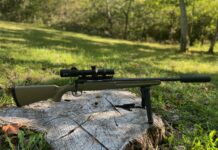I’ve had more than a few 1911s over the years. A couple of them required a barrel bushing wrench to disassemble. One of them required a barrel bushing wrench and a mallet. I got rid of those guns, both Les Baer 1911s in .45ACP. They were shockingly accurate guns, they just took a lot of maintenance. The necessity of a tool, or tools to disassemble them made maintenance much more difficult. Apparently I’m not the only one who’s annoyed no end by a tight barrel bushing. Dd Fab of Canada has created what they call the 1911 Gripwrench. It’s a barrel bushing wrench that has a little swivel hook on the side of it for 1911s with, in my opinion, overly tight bushings. While I already have a few 1911 openers, this one seemed worth a try . . .
First, I just wanted to see how well it works as a standard barrel bushing wrench. Please note: none of the 1911s I now own require a tool for me to disassemble them, but using one does make it easier. I shoot a little bit, so I’m disassembling a 1911 a couple of times a week and I’ve used all sorts of tools. The one I have with me all the time is the STI Bushing Wrench/Bottle Opener keychain. Pure genius, but it doesn’t have a handle and so it’s not the best wrench.
The Gripwrench actually makes a pretty great bushing wrench. It fits tightly over the bushing, has a long enough handle to be comfortable, and doesn’t mar the metal at all. I actually used it to attempt to scratch several different types of metal, to no avail. So I wouldn’t worry about it marring my guns at all. It’s also wide enough that it helps stop the spring cap from flying out, which everyone does at least once.
As far as the tight bushing part, I couldn’t for the life of me figure out how this gizmo worked – until I found a video that showed the process. Then it was head-slapping simple. The YouTube video shows how it works much better than I can explain it.
Now, I had to simulate the need for the swinging arm, as none of my bushings are that tight. If they were, though, this thing would work pretty well. If I had it back when I owned my Les Baers, I might have kept them and I certainly wouldn’t have had to bring a mallet to the range. Beyond coping with an overly tight bushing, shooters with limited dexterity in their fine motor skills – such as a friend of mine who can’t bend his index finger due to an injury – would benefit mightily from the Gripwrench.
In short, it works as advertised and it works well. It’s sold on eBay for $22.50, so it’s not a lot of change out the door and it provides additional functionality over the standard wrenches. All that said, if you have normal mobility in your fingers and you have a 1911 that absolutely requires tools to disassemble, I would highly recommend either fixing or replacing that gun first. But if you insist on keeping it as is, this little tool is a good buy.
Rating (out of five stars):
Overall: * * * * *
The 1911 Gripwrench works exactly as advertised and does its job well. If you have a gun that requires a wrench or your hands could use a little extra leverage, it’s the way to go.







The XO’s paraordinace was nearly a crew servrd weapon when it came to assembly and dissassembly. He could benefit from one of these but is too pinche.
No tools required to remove the barrel from a Glock.
Nope. Not until you blow a .355″ or .4″ or .451″ hole in your drywall.
The easiest gun to take apart is the Beretta 92. Push a button and turn a knob. Supposedly it’s possible to remove the slide from the frame from in front of the pistol, however I don’t worry about that since the trigger is on the shooter’s end.
Yeah, because there has never ever been a negligent discharge from a 1911 before cleaning it.
1911 people are like Obama. They wake up in the morning and delude themselves that they are the smartest wisest geniuses for embracing outmoded outdated philosophy.
Nah, there’s a major difference.
He just thinks he’s right.
I don’t mind the Glockers talking up their favorite gun. It’s just that they don’t have a point here. Were the 1911 any easier to field-strip, it would just fall apart. That a small percentage of 1911s require a bushing wrench doesn’t change that. Nor do the issues with full-length guide rods. Both problems are created by modifications to the original design. I’m sure we could think of a Glock mod that makes disassembly overly difficult.
Why do Glock fanboys have to insinuate themselves into every discussion about some other pistol? Feeling inferior about their purchase and seeking for vindication? Feeling superior about their purchase and needing to gloat? Fact is, the market for Glock accessories and replacement parts is large enough to confirm that thousands of Glock owners obviously don’t thing their OEM version is “perfection.”
Here’s a thought, keep the snarky comments to yourself, and stay out of the 1911 articles if they don’t happen to be your cup of tea?
I own Glocks and I own 1911s. Love ’em all.
How’s much? ?
$22.50
I realize this isn’t the point of the article, but thanks for pointing out the issues you had with the Les Baers, JWT. I’ve been thinking about getting a higher-end 1911 to celebrate a major life event, and this helps to prune the decision tree a bit.
For what it’s worth: I’ve owned a Les Baer Premier II with the 1.5″ guarantee for over twenty years. It is the most reliable gun I have next to my twenty-five year old, German made, SIG 226. I have never had a maintenance issue with it. The bushing does require a wrench, and I use a plastic one I bought from Brownells.
Having served from 1975 to 1995, I grew fond of the 1911. Now all my pistols are 1911except for a SA XD Mod2 .45acp and SW .44 magnum revolver. My .45acp’so range from Ruger,Kimber,Para USA, Desert Eagle. I like them enough I carry them ccw. I’m waiting for Springfield Armory to make the XDS Mod2 .45acp as a 4 inch.
John L, I know some great shooters that swear by their Les Baers. I just haven’t been able to tolerate their break in period.
Five will get you ten that those “overly tight” bushings were actually the gold cup collet type, and NOT overly tight at all…
Having a snug fit barrel bushing on a 1911 improves the inherent mechanical accuracy of the gun.
It’s not a problem that needs to be “fixed”. Those Les Baer 1911’s you got rid of were mechanically capable of shooting tighter groups than the sloppy loose 1911 you prefer. Does it matter for personal defense? A gun capable of 3″ at 25 yards is pretty much industry standard. If you are building a gun for handgun hunting, where you might want 3″ at 50 yards (instead of 25 yard) accuracy, or even better accuracy (some Les Baer guns are 1″ at 50 yard guns), putting up with the additional hassle of needing to use a tool to disassemble the gun might be worth it.
Lol @ Glock people popping up in the first few comments. Haters gonna hate. Sounds like you had two very nice 1911s that you got rid of because they were built well. Congrats. I guess you’ll stick with your Tisas (Girsan, Metro Arms, Rock Island, ATI, pick your poison) from now on. Its for the best. Nothin wrong with the lower end 1911s, I carry a slicked up ATI every day, but there is a significant difference in every aspect.
Thanks for the education genius. Guess this Wilson, Christiansen, ST Is and Colts I own are all “low end” as well.
Sounds like you’ve got it all figured out.
Looks like an overly complicated device at a high price to do a simple job. A normal and cheap wrench works fine for me. The demonstrator acts like he is unaccustomed to working with a 1911.
I am familiar with tear down methods. Slide off is preferred among match fitted parts. My other videos demo this, but I wanted to show a removal option that was impossible before the 1911 Gripwrench was designed. Some owners manuals still direct you to remove the plug first. Owners discretion.
I honestly cannot remember the last time I used a wrench on a 1911 barrel bushing. Maybe it is because my fingers have become accustomed to the pain and pressure of small parts.
A barrel bushing that needs a wrench to remove is tight between the bushing and the slide. It could be loose between the bushing and the barrel, and still be a bear to remove.
Bushings that are so tight you need to crank them off with a wrench might benefit from a little bit of very fine lapping compound applied to the bushing, the bushing cranked in/out of the slide a few times, then clean off all the lapping compound on both the bushing and the slide. Don’t get carried away, just lap down the bushing/slide fit a little bit to enable the bushing to be removed without a wrench.
Five will get you ten that its a collet type bushing he’s reffering to, and he doesn’t know to pull the slide back out of battery to loosen it and do it with fingers…..
Ken, it’s pretty obvious you don’t know what you are talking about, as the slide is entirely off the frame by the time the bushing is removed. A little education, maybe reading the Baer manual, would have saved you from some embarrassment there.
It is painfully obvious you haven’t the slightest idea what I was talking about. Solid bushings cannot be that tight, or the gun will not function. Collet type barrel bushings on a 1911 are only tight when the slide is in battery.
To disassemble one without tools one only needs to push in the recoil spring plug as normal, and then bring the slide back out of battery and the bushing can then be turned clockwise with finger pressure. Then remove the plug, turn the bushing counterclockwise, and remove. Push the slide stop pin out and pull the slide forward off of the frame. Now remove the recoil spring and barrel from the frame and it is disassembled. Guaranteed to work, but whether or not you try it is not. Perhaps you just wish to blather about that which you do not understand instead.
Try reading a little more carefully next time, and talking a little less. You have two ears but only one mouth for a good reason. And if you have a 1911 with a collet bushing, have it replaced with a solid one. The collet fingers break and tie up the gun requiring a gunsmith, which you obviously are not. The collet lockup only provided the smallest of accuracy improvement, and was only designed to be used in long range, untimed, military competition, with armorers standing by, and reshoots given, in the event of gun failure. Under those conditions, perhaps the collet bushing makes sense.
Now, five will get YOU ten(since I was not talking to you in the first place) that you haven’t the slightest comprehension what it was that I just said. Perhaps there is more to life than what you heard in some manual or other?
Ken, you were pretty rude, assuming that I did not know how to disassemble a 1911 with a collet type bushing. You were grossly mistaken. I appreciate you describing a takedown method for the 1911, but you have absolutely proven my point in your description, because the method you describe is the wrong takedown method. By the time the bushing is rotated to be removed, the slide should already be off the frame, the spring already removed, and the barrel is forward. This is the method recommended by the manufacturer of the guns that you bet I didn’t know how to disassemble and because of that, the method I use to disassemble them. You have proven, again, in spectacular detail, that you don’t know what you are talking about. Instead of continuing to make an ass of yourself you should just admit that you were wrong.
I do NOT mean to be rude, but if you would simply ATTEMPT this method you could not help but note that it works very well. If you will continue to refuse all new information, then there is nothing further to discuss. Without some effort, no learning is ever possible. Since it is clear that you believe that you already know everything, because you read a manual, any effort on my part to inform is simply wasted. That is a game I do not play.
Goodbye to you, and good luck.
Retracting the slide out of battery does nothing to improve the bushing to slide clearance. You are confusing it with the barrel to bushing fitment, in which case you may be correct. We are talking about the fit between ONLY the bushing and slide, barrel could be removed in theory for this topic. Thanks for the trolling.
You would be correct, IF the slide to bushing fit were what created the too tight problem in the first place, but its usually the collet fingers locking the barrel to the bushing that creates the so called ‘need’ for a bushing wrench. Simply pulling the slide back far enough to loosen the fingers will remove the ‘need’ to have a bushing wrench handy, in this, the most common case. Most of the accuracy improvement to be had(minuscule, in any case, but enough to perhaps make a difference in a long range competition, where first and second place might be separated by only ten thousandth of an inch at 50 meters) is the barrel to bushing fit, and NOT the bushing to slide fit. That doesn’t mean that SOME manufactures MIGHT just fit the bushing to the frame too tightly, but note that at the start of this thread Dyspeptic Gunsmith ALREADY ADDRESSED that issue.
You should learn the fact that all things that look like a 1911, ARE NOT. Since the patents expired on the 1911 design, it has gone in hundreds of different directions, and they are all different, so it pays to separate them, instead of put them into the ‘one size fits all’ category, because they don’t all. 🙂
It also pays to read carefully, and pay attention to the details. That way you look less foolish than you do when you just name call about issues in which you are mistaken.
D.G. I agree.
In general I have found an overly tight bushing adds little to accuracy. And as is the case with full-length guide rods, makes for unnecessarily difficult disassembly.
Tight slide rail fit also adds little to functional accuracy, and may degrade reliability.
Properly fitted slide/barrel/bushing and link will result in acceptable accuracy because when in battery all slide components are essentially one unit, and their relation to the sights does not change, regardless of any clearance or “slop” at slide rails.
To enhance accuracy, a clean trigger break may be more effective than over-tight fitting.
I recommend the Kuhnhausen manuals for more on these matters.
I believe reliability issues are amplified on internet forums due to the controversy they generate.
On 1911s these can usually be resolved by paying attention to chamber ramp/throat, recoil spring rate, extractor, and mag lips, sometimes the spring or the follower.
I do not own any plastic guns, so I will not comment on Glocks.
I dont know about all this talk about collet bushings. Colt has not installed them in a very long time. There is a reason for that. I do question excessively tight barrel bushings-they should be a snug fit, but taking a gorilla and a pipe wrench to remove them seems a bit much, and I question as to whether its necessary other than to ensure a tight bushing for the life of the pistol. Bushings do tend to loosen up over time, so maybe that is why.
I found a different way to strip my pistols down-clear the weapon, move the slide back to align the disassembly notch, push the slide stop through, then ease the slide off the frame, careful to control the recoil spring so it doesnt kink or go flying, then remove the spring and guide from the slide. Push the barrel forward about an inch or so, then rotate the bushing off the slide.
I did switch out all of my stock bushings on my Colts to EGW Angle Bore bushings which has taken about .008″ freeplay between the bushing and slide and the bushing to barrel fit, essentially taking them to zero play. I find it helps my groups a bit and the cost is low.
Lots of confusion up above from people who say it is so easy – but obviously have never had one of the guns. Having bought a Les Baer Premiere II, I know exactly how difficult it was to remove the bushing before I bought this tool. Twist it off with fingers? Not a chance. Even with the tool, it may have been easier, but I wouldn’t call it easy.
If someone enjoys a Les Baer, tight tolerances are part of what you get with the gun, and it’s up to you to go through the break-in period. If you don’t like that, buy a different gun.
The GripWrench works perfectly on all my 1911’s.
Comments are closed.